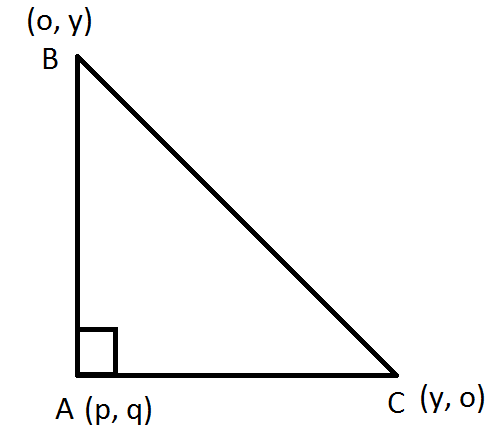Answer
425.1k+ views
Hint: a locus (Latin word for "place", "location") is a set of all points (commonly, a line, line segment a curve, or a surface) whose location satisfies or is determined by one or more specified conditions. In other words, the set of points that satisfy some property is often called the locus of a point satisfying this property.
The locus of a point P is such that it is equidistant from two given points. A and B i.e. PA=PB. The locus of a point at fixed distance d, from point P, is a circle with given point P as its center and d as its radius. Here in this question, we can use the distance formula for two given points.
Distance formula = \[\sqrt {{{(x_2 - x_1)}^2} + {{(y_2 - y_1)}^2}} \]
Complete step by step answer:

Let the point be \[(p,q)\]
\[B{C^2} = A{B^2} + A{C^2}\](By Pythagoras theorem)
\[{(4 - 0)^2} + {(0 - 4)^2} = {(p - 0)^2} + {(q - 4)^2} + {(p - 4)^2} + {(q - 0)^2}\]
\[16 + 16 = {p^2} + {q^2} + 16 - 8q + {p^2} + 16 - 8p + {q^2}\]
\[32 = 2({p^2} + {q^2} - 4p - 4q) + 32\]
Or \[{p^2} + {q^2} - 4p - 4q = 0\]
Replacing \[p \to x\]and \[q \to y\]
\[{x^2} + {y^2} - 4x - 4y = 0\] is the locus of the equation.
Note: we can also find this finding slope of two lines AB as \[m_1 = \dfrac{{y_2 - y_1}}{{x_2 - x_1}}\], and AC as \[m_2 = \dfrac{{y_2 - y_1}}{{x_2 - x_1}}\]
And for perpendicular lines\[{m_1}{m_2} = - 1\]
We get the required locus of the third vertex.
The locus of a point P is such that it is equidistant from two given points. A and B i.e. PA=PB. The locus of a point at fixed distance d, from point P, is a circle with given point P as its center and d as its radius. Here in this question, we can use the distance formula for two given points.
Distance formula = \[\sqrt {{{(x_2 - x_1)}^2} + {{(y_2 - y_1)}^2}} \]
Complete step by step answer:

Let the point be \[(p,q)\]
\[B{C^2} = A{B^2} + A{C^2}\](By Pythagoras theorem)
\[{(4 - 0)^2} + {(0 - 4)^2} = {(p - 0)^2} + {(q - 4)^2} + {(p - 4)^2} + {(q - 0)^2}\]
\[16 + 16 = {p^2} + {q^2} + 16 - 8q + {p^2} + 16 - 8p + {q^2}\]
\[32 = 2({p^2} + {q^2} - 4p - 4q) + 32\]
Or \[{p^2} + {q^2} - 4p - 4q = 0\]
Replacing \[p \to x\]and \[q \to y\]
\[{x^2} + {y^2} - 4x - 4y = 0\] is the locus of the equation.
Note: we can also find this finding slope of two lines AB as \[m_1 = \dfrac{{y_2 - y_1}}{{x_2 - x_1}}\], and AC as \[m_2 = \dfrac{{y_2 - y_1}}{{x_2 - x_1}}\]
And for perpendicular lines\[{m_1}{m_2} = - 1\]
We get the required locus of the third vertex.
Recently Updated Pages
How many sigma and pi bonds are present in HCequiv class 11 chemistry CBSE

Why Are Noble Gases NonReactive class 11 chemistry CBSE

Let X and Y be the sets of all positive divisors of class 11 maths CBSE

Let x and y be 2 real numbers which satisfy the equations class 11 maths CBSE

Let x 4log 2sqrt 9k 1 + 7 and y dfrac132log 2sqrt5 class 11 maths CBSE

Let x22ax+b20 and x22bx+a20 be two equations Then the class 11 maths CBSE

Trending doubts
Fill the blanks with the suitable prepositions 1 The class 9 english CBSE

At which age domestication of animals started A Neolithic class 11 social science CBSE

Which are the Top 10 Largest Countries of the World?

Give 10 examples for herbs , shrubs , climbers , creepers

Difference between Prokaryotic cell and Eukaryotic class 11 biology CBSE

Difference Between Plant Cell and Animal Cell

Write a letter to the principal requesting him to grant class 10 english CBSE

Change the following sentences into negative and interrogative class 10 english CBSE

Fill in the blanks A 1 lakh ten thousand B 1 million class 9 maths CBSE



